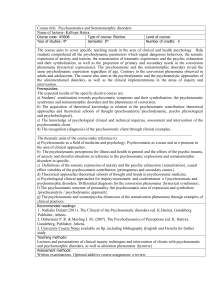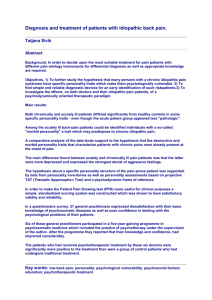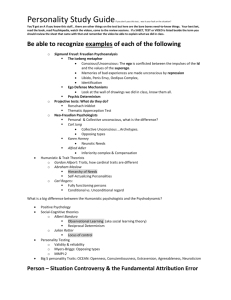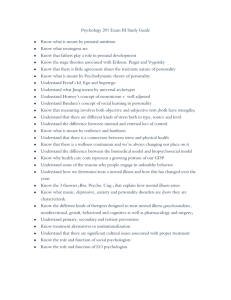AJA Teaching - Psychosomatic Disorders
advertisement
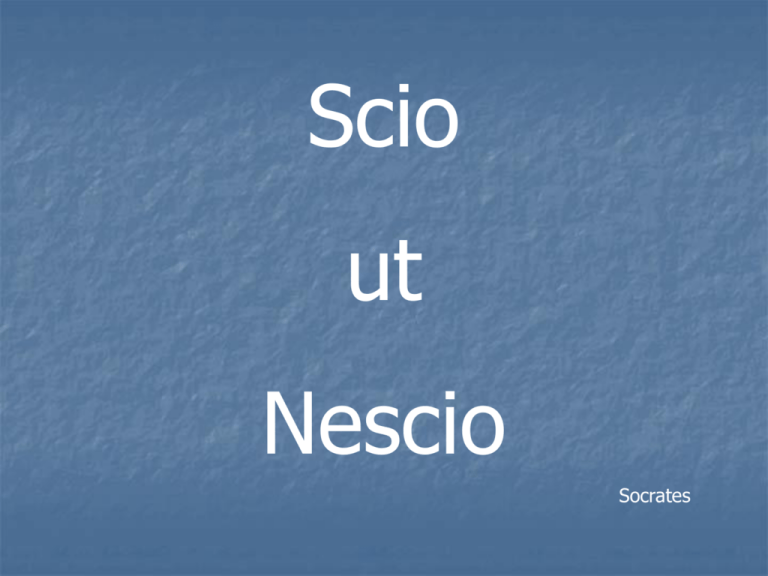
Scio ut Nescio Socrates John 9, 3: Healing of the Blind Man As he went on his way Jesus saw a man who had been blind from birth. His disciples asked him, ‘Rabbi, why was this man born blind? Who sinned, this man or his parent?’ ‘It is not that he or his parents sinned,’ Jesus answered, ‘he was born blind so that God’s power might be displayed in curing him.’ Jung, CW 7, para 221 ‘The process of assimilating the unconscious leads to some very remarkable phenomena. It produces in some patients an unmistakable and often unpleasant increase of self-confidence and deceit: they are full of themselves, they know everything, they imagine themselves to be fully informed concerning their unconscious…’ Denise Gimenez Ramos: Psyche of the Body A recent meta-analysis has found that emotional expressiveness is a predictor of cancer incidence (McKenna et al., 1999). Health Psychol. 1999 Sep;18(5):520-31. Psychosocial factors and the development of breast cancer: a meta-analysis. McKenna MC, Zevon MA, Corn B, Rounds J. Source Department of Educational Psychology, University of Ilinois at Urbana-Champaign, USA. Abstract A meta-analysis examined the relationship between psychosocial factors and the development of breast cancer. Average effect sizes (Hedges's g) were calculated from 46 studies for 8 major construct categories: anxiety/depression, childhood family environment, conflict-avoidant personality, denial/repression coping, anger expression, extraversion-introversion, stressful life events, and separation/loss. Significant effect sizes were found for denial/repression coping (g = .38), separation/loss experiences (g = .29), and stressful life events (g = .25). Although conflict-avoidant personality style was also significant (g = .19), the effect size was less robust, and a moderate number of future studies with null results would reduce the significance. Results overall support only a modest association between specific psychosocial factors and breast cancer and are contrary to the conventional wisdom that personality and stress influence the development of breast cancer. Psychosomatic Disorders Psychosomatic Reactions Conversion Symptoms Functional Syndromes Psychosomatoses (The Holy Seven) Psychosomatic Reactions Occur in stressful situations Examples: giddiness after narrow escape loss of appetite after bereavement Throbbing of heart when in love Common reactions, which disappear when triggering situation subsides Conversion Symptoms Secondary somatic response to a neurotic conflict. Symptoms have a symbolic character and may be taken to represent an attempt to solve the conflict Examples include hysterical paralysis, paraesthesia, psychogenic blindness, deafness, pain Is Chronic Fatigue Syndrome (ME) a modern-day conversion symptom? Functional Syndromes Various symptoms without identifiable organic cause. These can be related to a number of organs: Heart: palpitations, chest pain, dizziness Respiratory: hyperventilation, breathing problems Intestines: Non-ulcer dyspepsia, abdominal pain, diarrhoea (Irritable Bowel Syndrome) Musculo-skeletal: joint pain, back pain (Fibromyalgia) Neurology: Headaches, Sleep problems, Tics Psychosomatoses Understood as a primary physical reaction to a conflict situation or stress. There are objective organic findings ‘Holy Seven’ Bronchial Asthma Ulcerative Colitis Essential Hypertension Neurodermatitis (Atopic Eczema) Rheumatoid Arthritis Duodenal Ulcer Anorexia Psychosomatic Theories: Personality Typology Typology of personality associated with certain types of disease. Examples Accident Prone Personality: impulsive, adventurous, poorly controlled, living for the moment, unable to control their aggression towards authority. Accident as unconscious self-punishment to assuage guilt feelings Heart Attack Personality: perseverant, success orientated, self-constraint, controlled, aiming for distant target rather than immediate gratification Psychosomatic Theories: Conversion Model: Physical Illness as symbolic expression of an unconscious psychological conflict Desomatisation –Resomatisation: The process of maturation (Desomatisation) is interrupted by neurotic conflicts under stressful situations, leading to regression and physical illness (Resomatisation) Psychosomatic Theories: Disease Specific Psychodynamic Conflicts (Franz Alexander 1950) Psychosomatic Illness as ‘organ neurosis’ or ‘vegetative neurosis’: Emotional tension cannot be released psychologically and results in physical organ changes. The illness is specific to underlying psychological conflict Hypertension: inhibited aggression in controlled personality cannot be released to the external world and results in pent-up tension Duodenal Ulcer: Suppressed (super-ego) and frustrated unconscious desire to be pampered, nurtured and loved mobilises secretion of gastric acid and causes ulcer. Psychosomatic Theories: Alexithymia ‘Lack of emotion’ Based on observation that patient with psychosomatic illness displayed lack of fantasy, poor verbal expression, fixated on body manifestations, cut off from unconscious life, over-adjusted to environment Ego-regression to a primitive defence system with somatisation as expression of aggression and self-destruction; insufficient differentiation between self and object Psychosomatic Theories: Conditioned learning Psychosomatic symptoms as consequence of learnt reflexes Physiological predisposition released by learnt reaction Asthma: chest tightness with wheezing initially triggered by exposure to allergen. This results in increased attention from environment and in avoidance of disagreeable activity. In future asthma attack set off by wish for attention or avoidance of unloved task Psychosomatic Theories: Stress Stress (physical, emotional, social) results in challenge to the organism. If the individual succeeds in overcoming it, a sense of satisfaction is experienced. However, if defeat results in feeling of failure, exhaustion and various physiological changes (breathing, blood pressure, pulse, cortisol release) Psychosomatic Theories: Integrative Models Multifactorial origin of illness: interaction of genetic, microbiological, immunological, nutritional, psychological, social and behavioural factors Bio-psycho-social Model: ‘Translation’ of manifestations physical and psychological signals; attention to psychosomatic and somatopsychic aspects; attention to biographical factors; understanding of illness in the context life history; social implications of illness Viktor v. Weizsäcker: Psyche and body can interpret one another; ‘the soul enlightens us about the unconscious reason and passion of the body, the body teaches us about the natural needs of the soul’


